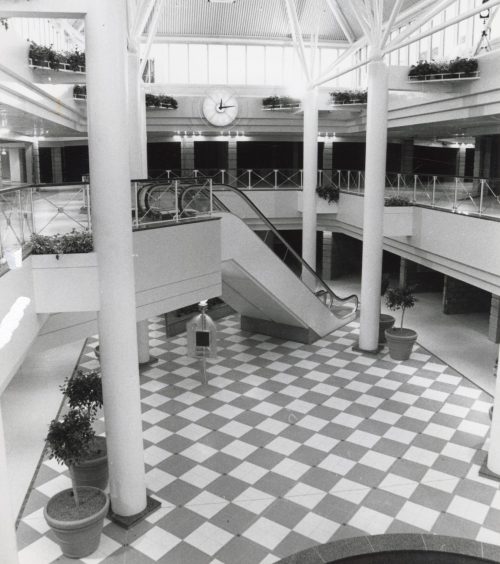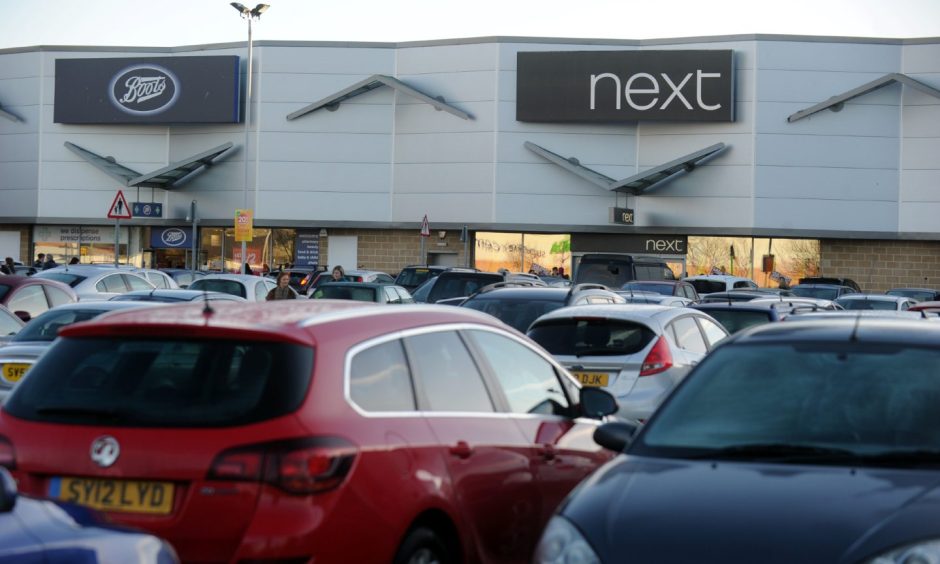
Since before the St Giles Centre was even open, there have been aborted plans for expansions and extensions of the Elgin shopping centre.
Initial plans were for the complex to be larger.
However, the financial collapse of the developers forced the blueprints to be scaled back just to get the doors open in early 1992, more than two years later than initially hoped for.
Over the last 32 years there have been repeated attempts to expand, extend and alter the St Giles Centre to boost High Street trade against the rising force of retail parks.
Here the Press and Journal looks back at the aborted plans for the St Giles Centre, why they were put forward, why they never came to fruition and what is being done today to boost occupancy.
Scaling back original St Giles Centre vision
When the original St Giles Centre developers collapsed, receivers were forced to pick up the pieces of the £20 million project.
Part of that included amending the plans, which resulted in six fewer units being built.
It did what it needed to do though, and just five months after permission for the amended plans was secured the centre opened in November 1991, albeit with no shops.
Initially it was marketed as a “tourist attraction”, with customers having to wait until February the following year for some shops to spend their money in.
Receivers Touche Ross had no intention of keeping hold of the St Giles Centre after inheriting it from failed developers Sheraton Caltrust.
So, in February 1994 they sold it to London-based investment firm Hanover Property Unit Trust at a sensational knockdown price.
Two years after being opened after a £20 million construction project, the St Giles Centre was sold for just £8 million.
Hanover Property were understandably delighted with the deal, hailing the “terrific potential” of their purchase.
And nine years later they moved to make the St Giles Centre a jewel in their crown with an ambitious extension plan.
How St Giles Centre planned to fight Edgar Road retail parks
After that troubled beginning, the St Giles Centre established itself as a mainstay of Elgin’s shopping scene through the 1990s and 2000s.
Occupancy rates quickly rose under Hanover’s stewardship and the owners were keen to ensure they were protecting their investment.
They were vocal opponents when Robertson applied to build their Edgar Road retail park next to The Wards, which now houses Matalan, Home Bargains and Pure Gym.
They joined Moray Council’s own planning officials in voicing fears that the plans would pave the way for retailers to leave the town centre.
And just one week after councillors went against the recommendation of planners to approve Robertson’s Edgar Road plans, Hanover submitted their own expansion blueprint for the St Giles Centre in October 2003.
The vision centred on using the derelict site of what was the site of the former Munro Baths next to Elgin Town Hall – on the opposite side of the A96 from the existing St Giles Centre.
Essentially, a second phase of the shopping centre would be built with a pedestrian link bridge built over the Aberdeen to Inverness road.
Hanover, together with its development partner Forres Developments, argued the extension was necessary to redress the balance of retail park applications.
A spokesman for Hanover’s planning consultants told the Press and Journal the plans were very much an outline and their full extent would depend on several factors.
He added: “They believe in the town centre and they are putting their money where their mouth is.
“They are not just doing it to fan the flames of their objection to the Wards development.
“It is a serious commitment to making things happen in the town centre.”
There was just one problem, Aldi already had their eyes on the same site.
Planning tug of war with Aldi
Aldi got to the Munro Baths site first and had already submitted a detailed planning application for their supermarket before the St Giles Centre expansion was even mentioned.
It didn’t stop Hanover and Forres Developments openly trying to court the discounter about teaming up.
Planning consultants suggested the St Giles Centre and Aldi could “pursue a larger proposal” together as an alternative to the supermarket.
Or even if the discounter went it alone, they suggested they could still redevelop the “remainder of the site”, while not being clear about where exactly their shopping centre expansion would fit.
For nearly a year, Moray Council had the two competing rival plans for the same site on the desk of planners at the same time.
In the end, their choice was made easy after it emerged negotiations between the St Giles Centre and Aldi had taken place ahead of the August 2004 planning decision.
Documents detailed that Hanover had “reached agreement” with Aldi to “work together” on land north of the A96 for a new bridge into the shopping centre.
A separate letter from Aldi’s property director added the firm was happy for a nearby car park site to be used to build other shops.
However, no pedestrian bridge or additional retail units were ever built on the north side of the A96.
Today Aldi wants to leave the site itself saying it is too constrained to allow it to expand its Elgin supermarket.
Instead, it is eyeing up a spot on the very Edgar Road retail park that the St Giles Centre owners of the time objected to.
New shopping centre owners continue fight against retail parks
By 2011 the St Giles Centre was in new hands with Aviemore-based Upland Investments taking over from Hanover.
However, the same worries persisted about the impact retail parks were having on shopping in the town centre.
In September that year Upland Investments and Robertson objected to plans from the British Land Company to sell all kinds of non-food products at its Springfield Retail Park on Edgar Road, which today houses Boots, Currys and Next.
Despite also owning a retail park across the road, Robertson argued the move would negatively impact its town centre interests.
Meanwhile, the St Giles Centre said the move could lead to High Street businesses shutting up and moving to the out-of-town site.
Just months later in April 2012, Upland Investments and Robertson unveiled plans for a £7 million expansion of the St Giles Centre.
The vision was expected to nearly double the size of the shopping centre with an extension into what is currently Claire’s Accessories with another addition built over the bus station.
It was hoped the plans would attract new retailers following a string of closures including New Look, JJB Sports and Dorothy Perkins.
Robertson said they had already had interest from “a number of national retailers” about the plans.
David Cameron, a director of Upland Investments, added: “To protect Elgin and provide stability for the future the town centre needs to grow and attract the kind of retailers that will make it a destination for shoppers from all over the area.”
What happened to St Giles Centre extension?
When the St Giles Centre expansion from Upland Investments and Robertson was approved in October 2013 it was hailed as a “momentous day” for Elgin High Street.
It was estimated the project would create up to 210 jobs and revitalise the wider town centre area.
Apart from some initial work to upgrade the toilets, the St Giles Centre expansion hasn’t come to fruition.
Less than a year later in June 2014 and Upland Investments voluntarily appointed liquidators.
Documents filed at Companies House explain the decision was taken due to the company not being able to continue as a business due to its “liabilities”.
The St Giles Centre is now operated by St Giles Shopping Centre Holdings, which has former Upland Investments director David Cameron as its sole director.
However, title deeds held by the National Registers of Scotland show the land underneath the shopping centre is owned by the pension fund of the company formerly known as Imperial Tobacco, now called Imperial Brands.
Documents show St Giles Shopping Centre Holdings Ltd entered into a 125-year lease with Imperial in March 2014, just three months before Upland Investments folded.
When the site was listed for auction last year the annual lease, which runs until March 27, 2139, costs £217,800.
New vision for the St Giles Centre being developed
While the St Giles Centre expansion plans have never come to fruition, it has not stopped examinations being done to repurpose it for alternative uses.
Concerns about retailers leaving it due to competition from retail parks have proved to be founded with Mountain Warehouse and New Look among former tenants that opened up on Edgar Road.
Data compiled by the Press and Journal in October found the St Giles Centre was exactly 50% full with 13 occupied and unoccupied units.
Talks have been held about examining alternative uses for the vacant spots.
At one point the centre was earmarked as the potential home for UHI Moray’s aerospace campus before the university pulled out due to funding worries.
Meanwhile, NHS Grampian also confirmed this year they were considering the building for a “community and wellbeing hub”.











Conversation